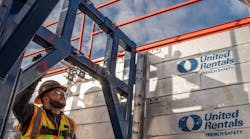By Bruce Magee, Region Project Development Manager, United Rentals
Veteran construction workers can pass a lot of valuable information down to newer employees, but when it comes to following OSHA’s trench safety regulations, it’s wise to double check the standards. Long-time supervisors may believe they understand the ins and outs of OSHA excavation standards when in fact they’ve been doing things wrong for years.
The results can be deadly. In 2022, 39 construction workers were killed in trench-related incidents. That’s a significant increase from the average of 21 trench-related deaths per year between 2011 and 2018.
In a recent trench safety webinar, Bruce Magee, United Rentals region project development manager, discussed the misconceptions about trench safety he’s heard most often during his decades in the industry.
1. Misconception:
RPE stamps are required only when a trench is deeper than 20 feet
In these cases, the OSHA specifications may not apply, or the engineer stamping the tabulated data did not factor these surcharges into the calculations. If the surcharges have not been considered in the loads, then an RPE should approve the protective system to ensure it complies with the OSHA standards.
Contractors using a trench box or other manufactured protective system in a trench of any depth can follow the manufacturer’s tabulated data rather than consulting an RPE, but if any unusual conditions exist at the site, check with an engineer to determine if the tab data still applies.
An RPE is also required to approve all manufactured protective systems for which there is no tab data, including cantilevered or braced steel sheeting, beam and plate, and beam and lagging.
2. Misconception:
OSHA regulations always supersede manufacturer’s tabulated data
OSHA outlines specifications for various trench protectives systems in appendices B, C, and D of Standard CFR 29, Part 1926, Subpart B – Excavations. However, there are times when the manufacturer’s tabulated data differs from these specifications. If they do, follow the tab data.
One example: OSHA trench regulations specify that no one can be in a trench box while it is being installed, removed or moved vertically, but they don’t prohibit workers from being inside during horizontal moves. However, because some workers have been injured during horizontal moves, some manufacturers now specify in their tabulated data notes that no one can be in a trench box while it is being moved in any direction.
3. Misconception:
Tab data takes surcharge loads into account
A surcharge load is the downward pressure on soil due to a heavy weight adjacent to the trench, such as from heavy equipment, a large spoil pile or tractor trailer traffic on an adjacent highway. Contractors often don’t realize that manufacturers’ tabulated data for trench boxes are not designed for those surcharge loads.
For example, the tab data for manufactured systems may allow for 0 to 72 pounds of weight per square foot (psf) on a site, but a trench adjacent to a highway may have a surcharge load of 72,000 pounds or more. When a surcharge load is involved, consult an RPE to determine the limitations of the trench box when the load is included.
4. Misconception:
Pulling on the spreader bars to move shield boxes is a common practice, but most manufacturers now state in their tabulated data that spreaders should be used only to hold the box walls in place, not for pulling the box up or relocating it in any way.
5. Misconception:
Arch spreaders are interchangeable with pipe or beam spreaders when calculating the allowable depth of a trench box
Although arch spreaders serve a purpose similar to that of pipe or beam spreaders in supporting the walls of a trench box, they carry the load differently. Pipe and beam spreaders are located lower in the shield; the upper spreader works in tension, and the lowest spreader works in compression to keep the shield walls apart. Because an arch spreader generally carries the load up and over large pipe or structures. The geometry is different, and this often results in larger boxes, or boxes with PSF ratings, to be downgraded. Compare the tab data of the shield to that of the arch spreader—the arch spreader data will tell you the maximum PSF they can bear, which can be used to determine the depth rating. The competent person may need to consult with an RPE.
6. Misconception:
Most trenches don’t require atmospheric testing, but testing may be necessary when trenching projects involve work in and around sewers, gas utility systems, landfills, refineries, chemical plants or hazardous waste dumps. Testing may also be needed when certain activities, such as welding or mixing chemicals, take place in the trench.
7. Misconception:
The only way to get authoritative information about trench safety is wading through the OSHA standards
If you’re uncertain how to apply trench safety rules to your excavation or want to confirm that your protective system complies with OSHA excavation standards, consulting the United Rentals Trench Safety group is a good place to start. United Rentals has years of experience in trench safety and a team of in-house RPEs to assist with protective system design and provide approval.
Other good sources of trench safety information include:
· OSHA Standard 1926 Subpart P, which outlines excavation regulations.
· OSHA Standard 1926.652, which covers the requirements for trench protective systems.
· The Federal Register. It has a searchable website that provides information about the intent behind the OSHA rules.
· The OSHA Technical Manual. It has a chapter on hazard recognition in trenching and shoring.
· OSHA’s Trenching and Excavation Safety Fact Sheet. A Spanish version is also available.
· OSHA’s Quick Card on Working Safely in Trenches, available in English and Spanish, which provides at-a-glance, high-level reminders about trench safety.
Don’t take chances with worker safety by assuming that what you’ve always heard or assumed about trench safety practices and procedures is correct. Doublecheck your protective system plans to ensure they meet the requirements set out by OSHA and, when applicable, the system manufacturer. That simple step could mean the difference between a safely completed project and an unnecessary tragedy.
Contact the United Rentals Trench Safety group for help with all your excavation needs.





